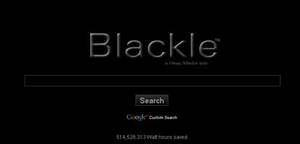Instead of the generous amount of white space which has characterised Google's home page since its 1998 launch, the page is mostly black.
Heap Media, the Australian company behind Blackle, claims black pixels take less power than white and so using its search saves energy. It believes that small things matter when it comes to reducing our energy use, limiting our CO2 output and reducing the likely extent of global warming as a result of human activity.

|
| ©Blackle |
| Blackle has got some people thinking about hi-tech energy use |
Whether or not turning off a few million white pixels makes a measurable difference is debatable, and Google has challenged the assumptions behind Blackle, especially when it comes to LCD screens.
It seems to matter for old-style CRT monitors but not for flat screens, according to a paper written in 2002 by Judy Roberson and others which noted: "among the few LCD monitors in the table, the power used to display a white screen is indistinguishable from power used to display the desktop.
"Thus, it appears that display color is a significant determinant of on power for CRTs, but not for LCDs."
The main factor controlling energy consumption for LCDs is the backlighting. Something well known by anyone who has turned down screen brightness and seen the battery life on their laptop take a leap.
So Blackle, for all its good intentions, may have saved a few kilos of carbon for heavy Google users with old monitors, but it can't be used to salve the consciences of the laptop warriors.
Which is perhaps a shame as there seems to be a lot to feel guilty about.
In December 2006 commentator Nick Carr published a widely-read and deeply-contested claim that each active 'avatar' in Second Life used as much electricity as the average person living in Brazil, noting that 'avatars aren't quite as intangible as they seem. They don't have bodies, but they do leave footprints'.
The calculations Carr relied on were rough and ready, as he admitted, and although the headline figure lives on in the blogosphere the real power use seems to be a lot lower, but his claim did get many people to think about their energy use for the first time.
Now Steve Souders, the author of the excellent 'High Performance Web Sites', has taken the debate a stage further by looking at the power consumption implications of poorly-designed web pages.
He picks on Wikipedia, where the home page has thirteen images that must be fetched over the network every time the page is viewed.
He argues that this inefficiency costs 5000 kwh (kilowatt hours) per year, or around 2000kg of CO2, arguing that making pages faster is 'good for your users, good for you, and good for Mother Earth'.
I'll see if I can make my home page more efficient, if that will save the planet, but of course there is always the sense that whatever I do on my personal site doesn't matter because my life's entire carbon savings will be wiped out the next time a thoughtless rockstar or self-important Silicon Valley executive flies across the Atlantic in their personal jet.
We need a way to show that what we do at a personal level counts, because the actions of millions will make a difference, and it may be that the network is the best way to get that information.
A number of big hi-tech companies have started to take green computing seriously, offering processors and systems that consume less power.
As part of a project it calls 'Big Green', a play on its nickname of 'Big Blue', IBM has been adding energy-monitoring technology to its mainframe computers, letting those with a System Z9 have access to what it calls a 'mainframe gas gauge'.
This is similar to electricity display devices like the Wattson, showing how much power a home or office is using.
Once you know how much energy is being used you can reduce electricity consumption by turning things off or, in the case of a multi-million dollar computer centre, changing the way jobs are scheduled so that more efficient use is made of the resources available.
But what we really want are smart meters that do more than simply report electricity use but also allow some feedback. The smart meters that are being installed in the UK in the next few years will allow real-time billing and could even let those with solar or wind power at home sell the electricity they generate back to the power grid when they aren't using it themselves.
Perhaps we need something similar for our websites and online services, a super-smart meter that can calculate how much power is being used serving my web pages, hosting my Facebook profile, running my Second Life avatar and, of course, dispatching my messages to my Twitter friends.
Like many other internet users I keep the clocks on my computers synchronised using the Network Time Protocol, a standard way of sending out a time signal. Perhaps we should develop a Network Energy Protocol that lets servers and services report their electricity consumption in real time, so I can change my usage patterns.
It would have a lot more impact than symbolically turning off a few white pixels.
And low-carbon footprint social network sites might even have a marketing advantage with more environmentally-aware teenagers.



Reader Comments
to our Newsletter